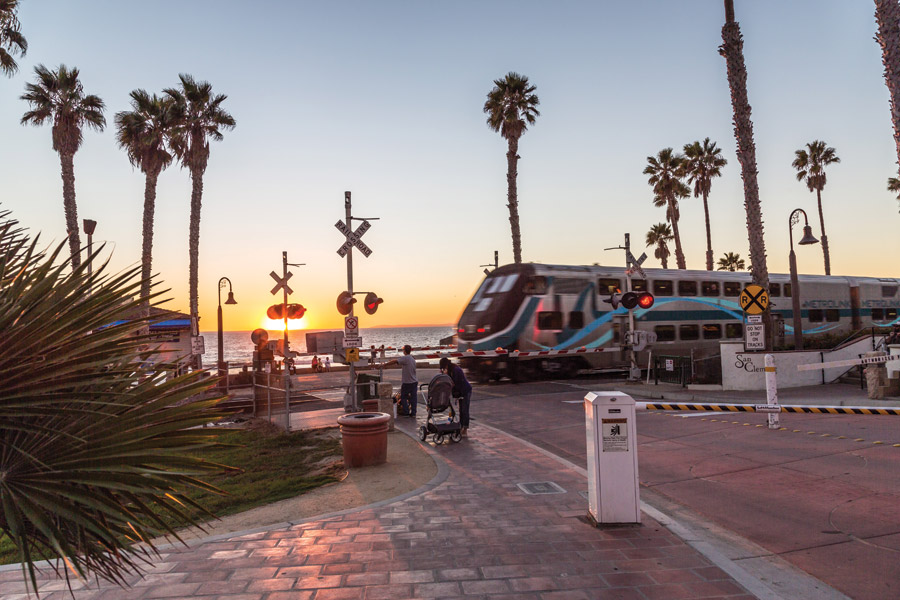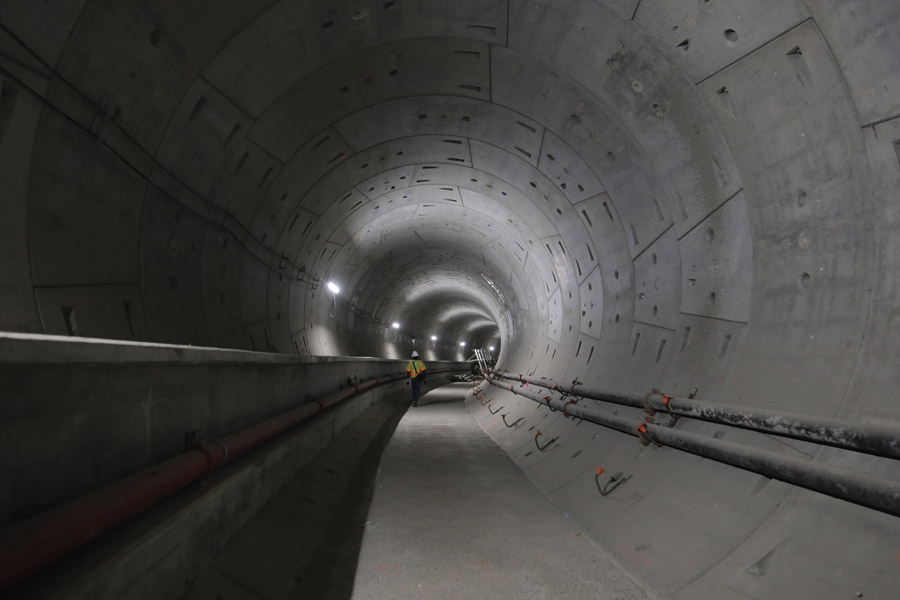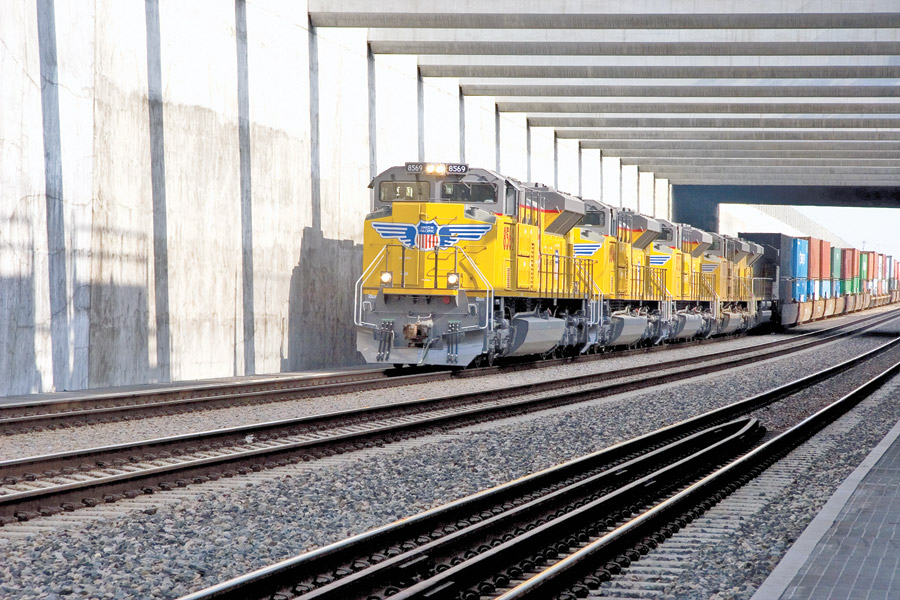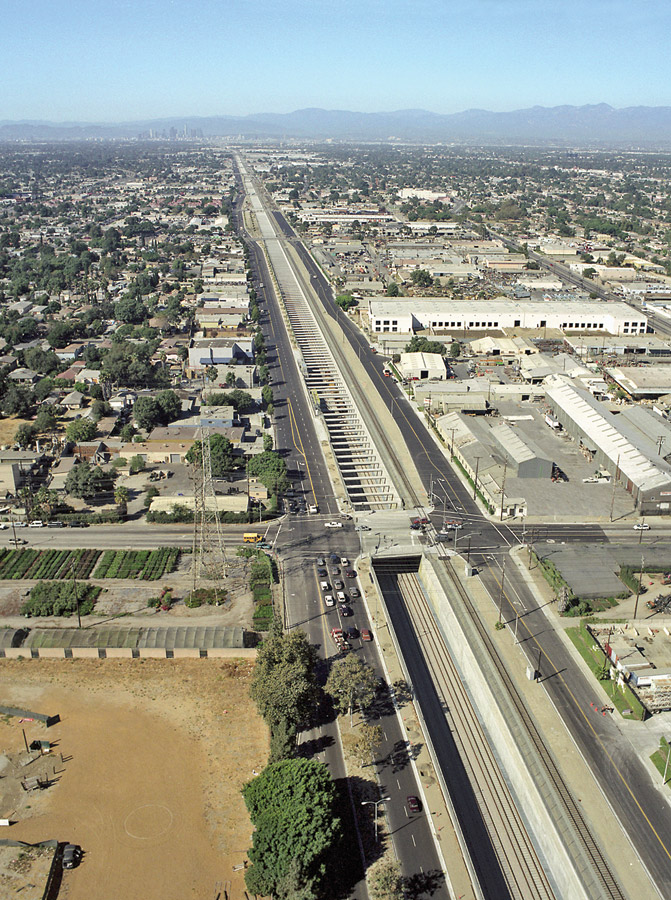Legacy Award | Southern California
Legacy Award Winner John Rinard Makes Tracks in SoCal and the World

Pinard cites his early years working for a freight railroad as a key to his success.
Photo courtesy AECOM
After he became a go-to transportation project leader in Southern California, John Rinard made his way around the globe, building projects in South Korea, Libya, Saudi Arabia, Qatar, the Philippines and Australia. After earning his civil engineering degree from the University of Utah in 1983, “I wanted to see the world and be challenged by something big,” says Rinard, now transportation program director for AECOM’s U.S. Western region.
But before any of that could happen, he literally got railroaded for seven years—by Southern Pacific Railroad.
“A guy named Mike Baker called me up, and he was kinda pushy,” recalls Rinard. “He said, ‘We’re this big railroad,’ but I wasn’t interested. I said the only time I got is 6 a.m. tomorrow. He said, ‘I’ll have coffee on at 5.’” So Rinard and his wife drove in a snowstorm 30 miles to the Ogden railroad depot. “The lights are on, and Baker was there with coffee. In two hours, he convinced me of the wonderful world of railroading.”

Rinard’s railroad experience informed the delivery of a new commuter rail link, Metrolink.
Photo courtesy AECOM
He has since applied that railroad experience to numerous rail and transit projects, including the Metro Blue Line, Alameda Corridor, Metrolink and California high-speed rail efforts in Southern California in addition to projects around the world. “I learned it was lucky for me to work for a Class 1 railroad, where I learned the why behind their standards,” he says.
He adopted railroad lingo as well, using it to describe his career: “I was a gandy dancer—the people who first built railroads. They followed the building. They’d build one line for miles, then when they got too far from home, they’d go to another job and build another line.”
Colleagues describe Rinard as a problem-solver and promise-keeper. “I worked with John on several projects since 1991, when he was with Southern Pacific,” says Jacqueline Patterson, co-founder of Zephyr UAS/Rail. “When we first met, he was the SP rep for the Blue Line project. Then I came across him on Metrolink, and we were able to open in 1992 under his leadership. Then he ended up at TriRail in Florida. He called and said, ‘You did a good job on Metrolink. Can you help us?’ We got a piece of that work.
“So our paths have crossed several times. He wants to get projects done. He finds a way. A lot of people were skeptical about the initial phases of Metrolink being done in two years. He pushed us with leadership and guidance to get it done. He’s one of those people who, when he promises, he’s going to move heaven and earth to get it complete.”

Rinard helped build the Blue Line connecting downtown Los Angeles with Long Beach via rail.
Photo courtesy AECOM
After leaving SP, Rinard served as director of engineering and construction for the Southern California Regional Rail Authority—now Metrolink—to lead a $2.5-billion project to build a new freight and commuter system covering 550 miles.
“John has always been a person for whom ‘no’ isn’t an option,” says Rachel Vandenburg, who served as lead engineer on the effort. “Working with him during the herculean effort to get the Metrolink commuter rail system ready for revenue operations, I saw it firsthand. His own passion to deliver helped drive the whole team—whether agency staff, consultants or contractors—to meet the challenge. And Metrolink carried its first passengers in October 1992, exactly as promised.”
“John has always been a person for whom ‘no’ isn’t an option.”
—Rachel Vandenburg, Former Lead Engineer at Metrolink
Richard Stanger, former director of Metrolink, recalls another herculean effort—to get trains running again after the 1994 Northridge earthquake. “It happened on a Monday. By that Wednesday we had 14,000 on the train,” he recalls. “John was in charge of getting that line and stations up and running in four days.
“He had an amazing amount of knowledge about railroad design and maintenance for so young a person,” Stanger adds. “His style is calm but strict—he knows what he’s doing and tells people what they need to do. But he also gave his field people lots of latitude in making onsite decisions.”
Rinard moved on to stints at DMJM and Bechtel, managing rail projects around the world. While at DMJM, he played a key role in the building of the Alameda Corridor, a 10-mile-long, 30-ft-deep trench that fast-tracks freight from the ports of Los Angeles and Long Beach to rail lines inland (ENR 5/29/00, p. 96) that helped bolster Southern California’s position as a major Pacific shipping gateway.
“He served as program manager for the preliminary engineering phase of the $2.4-billion project,” says Gill Hicks, who was the general manager. “I would often walk into his office unannounced, and he would typically greet me with, ‘How we doin’?’ This was not a sign of insecurity on his part, but rather a reflection of his main priority, which was to keep his client happy. He knew how important it was for the project to stay on schedule and within budget. He understood that time was of the essence, as project funding opportunities, coalition building and public acceptance are typically dependent on project readiness. His orientation was always to solve problems, motivate staff and keep moving. That’s why we got along so well.”
Rinard has his own variation on the story. “[Hicks would] say, ‘How can I help?’ and I’d say the same, and we’d make a deal,” he recalls. “I’m a businessman at heart. On these big jobs, I always say that if I need a report from some new engineer to see if my project is in trouble, I’m already in trouble.”

Rinard brought his railroad experience to the Alameda Corridor project.
Photo courtesy AECOM
Going Back to Cali
Rinard spent the first decade of the 2000s working with the contractor Herzog on rail projects throughout the U.S., such as in Fort Lauderdale, Seattle, Salt Lake City and Denver.
Ray Holdsworth, who had recruited him to DMJM, sought to get him back again—now to AECOM. “I had created a different kind of organization in DMJM way back when,” says Holdsworth. “I was looking for the best and brightest I could find. He fit the bill perfectly.”
Rinard’s personality did require a “dotted line” outside of the standard organizational chart, Holdsworth adds. “I knew if we put him into a regular slot, it wasn’t going to last long. John sees the big picture; he’s very decisive. He doesn’t tolerate organizational structure real well.”
Holdsworth cited an Army saying of two missions: transmit and receive. “John excels at transmitting,” he says. “If a decision is wrong, he just makes another one tomorrow to correct it. He’s not necessarily tactful. If you know the personality, you can form the organization and personnel around him. Build a strong technical team around him, and he leads them. Management is one of his strengths.”

The Alameda Corridor is a key piece of the region’s economic power as a shipping gateway.
Photo courtesy AECOM
Rinard led AECOM’s Libya office for two years, building a $65-billion program of housing and infrastructure. The scope included 227 contracts, six regional offices and 300 personnel. This included full infrastructure for 62 cities and more than 120,000 new homes. Then he spent two years in Australia, managing billions of dollars in mining projects. That included the $7-billion West Pilbara project, an iron ore operation that included 320 km of rail, a new deepwater port and mine processing facility, mining camps and roads. “I love the mining industry,” says Rinard. “It’s so fun and challenging. They want innovation; they have a can-do attitude.”
He spent the 2010s with CH2M Hill and Parsons Corp. building megaprojects in the Middle East. “The Riyadh project was a 100-mile metro system built all at one time in the capital city,” he says. “My portion was $17 billion. I had 32 nationalities working for me and two very large design-build contracts with full scope from design through vehicle procurement and start-ups.”
Then he returned to the U.S. to aid in high-speed rail efforts in California and Nevada before returning to AECOM as transportation program director. “I found that I’m a half-inch deep and 10 miles wide in experience,” he jokes. “One lesson learned—you’ve got to have deputies. I love bringing on new people who want to be challenged. I look for those who are confident, who are not afraid of working themselves out of the job. Then I have to get them on another job.”
“I was looking for the best and brightest I could find.”
—Ray Holdsworth, Former AECOM Vice Chairman, on Recruiting Rinard
His mentorship seems to have rubbed off on his children. One son works for Parsons, another son and a grandson for Kiewit, and a daughter is married to an employee with Sundt, he says.
The need to mentor more industry talent is clear. Currently, he is supporting AECOM with bid proposals on major projects. “It seems there is a lack of experienced project directors and managers,” he says. “I work to assemble great teams and may put my name in again soon.”
For all his global experience, he says that Southern California “offers some of the biggest and best transit and large civil projects—an opportunity to get involved in large, complex and highly challenging delivery. It is for those who wish to work hard and be challenged. The projects are career makers for young engineers.”
Although currently based in Yorba Linda, Rinard spends his spare time in his southern Idaho birthplace near the Snake River on his 34-acre ranch. “We raise 14 cows, 20 calves and a big bull,” he says. “The place is 10 miles off the Oregon border. It was a dream of mine since my childhood, when my father wanted me to become an engineer.”




